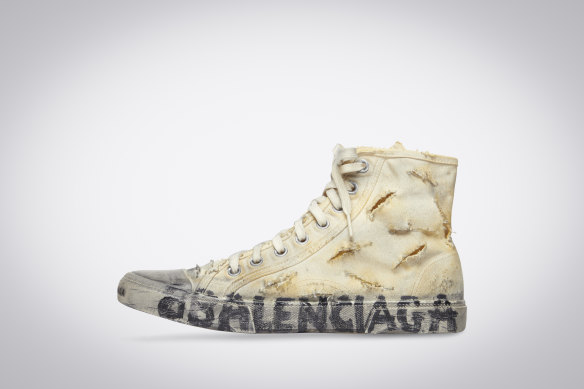By Marion Hume
Every writer of fiction will tell you they’ve had an “I cannot believe this!” moment, where life unexpectedly imitates their carefully crafted art. One of my recent favourites was in the 2021 novel, Happy Hour, in which protagonist Frannie becomes a home recluse and drinks too much – this imagined by author Jacquie Byron long before we’d heard the term “lockdown”, nor worked out how well it hyphenated with “chardonnay”.

Fashionable sneakers, such as this Balenciaga deliberately distressed one, make an outsized contribution to climate change, even before they end up in massive dumpsites.
Yet honestly, my own experience is ridiculous. With co-author Andrew Lamb, I’ve written a romcom about climate change set at Paris Fashion Week. Yes, you read that right. Without giving too much away, the aim of In Deep Chic is to celebrate everything we adore about Paris while questioning a global culture of over-consumption that’s spun out of control.
When you write drama, you’re always looking for “the one getting away with it”, and in the case of fashion, that’s what we put on our feet. It’s no news that fast fashion has a heinous environmental and ethical impact. But have you given a thought to how speedily sneakers have morphed from “fugly” functional footwear worn by the likes of Bill Gates to “super-hot”, worn by everyone under the sun? And what that’s doing to a warming world?
Sneakers are today’s “It” item. Made mostly from synthetic components, they’re also making an outsized contribution to climate change, and that’s even before they end up in massive dumpsites in places like Dandora on the outskirts of Nairobi, Kenya or Kpone in Accra, Ghana. There, that non-biodegradable slice of ethylene vinyl acetate which makes for a comfy, shock-absorbent midsole can hang around for 1000 years and leach toxins into the earth. The sportswear giants tell us they take back old sneakers and crush them down into bouncy surfaces for playgrounds – but how many of those can the world possibly host? All in all, with commendable exceptions like Allbirds and Veja, sneakers are sneaky carbon polluters.
Which brings me back to my romcom and life-imitating-art experience. Our plot centres around a beaten-up old sneaker that’s been dug up from a dumpsite and “returned to sender” to become the most talked-about shoe in Paris. So imagine our surprise last month, when images of a beaten-up sneaker which looks like it’s been dug up from a dumpsite became the most talked-about shoe on Instagram.
When Andrew and I first saw Balenciaga’s deliberately distressed Paris Sneaker, we were speechless. Okay, that’s not true – I started several sentences with “WTF …” As, indeed, did hundreds of thousands of others who took to social media to vent about a “must-have” item many saw as fetishising poverty, at no less than $2250 a pair. Debate about the Paris Sneaker generated an estimated $5 million in media-impact value in just 48 hours. You couldn’t make it up. Yet there we were, having done, well, pretty close to that.
Balenciaga’s disruptive creative director, Demna Gvasalia, is great at getting attention, as the Paris Sneaker melee shows. But what if he got the fashion world talking instead about the future of footwear, of using natural or recycled materials which, at the end of a long life, might fully decompose? Harnessing its creative energy not to make faux poverty trendy but to work out what billions of people should be putting on their feet?
Now that’s a trend I could get behind.
To read more from Good Weekend magazine, visit our page at The Sydney Morning Herald, The Age and Brisbane Times.